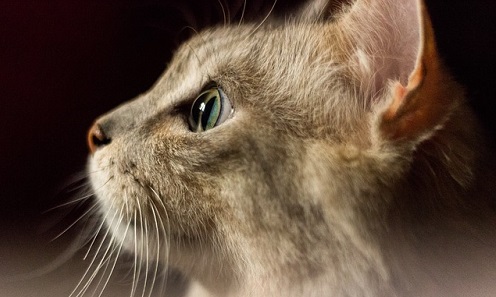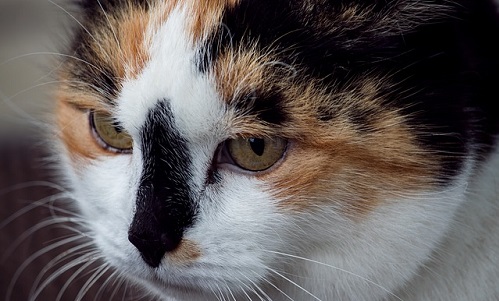If you’re like most cat owners, the health and wellbeing of your cat are always at the front of your mind. And the truth is, there’s a lot out there that can affect the health of your cat or put him in danger of serious injury or death.
If it’s not coyotes and cars, it’s colds and respiratory infections. Some things, such as coyotes, you can’t control, but there are plenty of things you can do to prevent respiratory infections, such as pneumonia in your cat.
That’s why the experts at Canna-pet have put together this article to fill you in on the symptoms of cat pneumonia. That way you’ll be in the best position to catch the infection before it worsens. This is important because it’s well known that the earlier you catch a respiratory infection, the easier it is to treat.
The simple reason for this is that the longer an infection has to take root, the more ‘defense’ systems it can build. For example, lots of microbes (the leading cause of pneumonia in cats) will develop what’s called a biofilm around their colonies.
A biofilm is basically a thin sheet of material that is hard to puncture. This means that antibiotics may be less effective after biofilms are put up. The biofilm acts as a shield that the antibiotic cannot get through.
This is why it’s important to regularly check on your cat and bring him to the vet if any signs or symptoms of pneumonia should occur.
This article will cover:
- What exactly is cat pneumonia?
- What are the causes of cat pneumonia?
- The signs and symptoms of cat pneumonia so you can spot them and get your cat healthy again.
- What to do if you notice your cat has the signs and symptoms of cat pneumonia.
- A powerful supplement you can give to prevent and help treat pneumonia in your cat.
What is Cat Pneumonia?
Pneumonia is a condition where the lungs and lower respiratory tract become inflamed. To help you picture this, it may be helpful to know that respiratory systems consist of two tracts.
The upper tract is the nose, sinuses, throat, larynx, and windpipe.
The lower tract consists of the smaller airways, such as the bronchioles, lungs, and surrounding tissues.
Cat pneumonia falls into two broad categories. The first category is microbial pneumonia (more commonly called bacterial, fungal, or viral pneumonia) and the second is aspiration pneumonia.
Microbial pneumonia is caused by an infection. Many times the infection starts as a viral infection which opens the doors to a fungal or bacterial infection.
Microbial pneumonia is considered a serious condition and will often require a trip to the vet. If you think your cat may have microbial pneumonia, you should bring him in right away.
Microbial pneumonia is usually caused by a weakened immune system and exposure to microbes. For example, some cats may get fungal pneumonia after digging in contaminated soil.
 The other type of pneumonia cats can get is called aspiration pneumonia. Aspiration pneumonia occurs when a cat inhales a foreign object or foreign matter, or if they vomit stomach acids into their airways.
The other type of pneumonia cats can get is called aspiration pneumonia. Aspiration pneumonia occurs when a cat inhales a foreign object or foreign matter, or if they vomit stomach acids into their airways.
The most dangerous part of aspiration pneumonia is the chance of obstruction of the airway. Long-term damage to the lungs is also possible in this case.
Aspiration pneumonia is caused by the lungs becoming inflamed from bacteria that came in on the foreign material, or from irritants causing a weakened immune system.
For example, if your cat is forced to inhale smoke, smog, toxins, or other pollutants, he could be at a higher risk of developing pneumonia. Make sure your cat has access to clean air so he can breathe with healthy lungs.
What Causes Cat Pneumonia
So you know cat pneumonia is most commonly caused by a microbial infection, but what little bugs should you keep your eyes peeled for?
The truth is that any respiratory infection will be caused by a whole host of different bacteria. This is because most strains of bacteria work best in groups, sort of like placing certain plants together in your garden.
But though an infection will have multiple microbial instigators, here are a few of the most common ones you can ask your vet about:
- Bacterial:
- Bordetella bronchiseptica
- Pasteurella
- Moraxella
- Chlamydiae. This type of bacterial infection usually develops alongside the more common chlamydial conjunctivitis and rhinitis. The specific strain that causes pneumonia is chlamydia psittaci
- Fungal:
- Aspergillus species
- Blastomyces dermatitidis
- Candida species
- Coccidioides immitis
- Cryptococcus neoformans
- Histoplasma capsulatum
To prevent microbial pneumonia, make sure your cat always has access to clean air and clean water. Also avoid areas where cats may be heavily congested, such as kennels.
So we may have succeeded in scaring you with the hard to pronounce names above. Don’t fear, if you keep a sharp eye on your cat, you’ll be able to spot the signs of pneumonia before the infection becomes a problem.
Cat Pneumonia Symptoms
While every infection is unique and every cat will be affected differently, there are some symptoms that are likely to occur when pneumonia is present. One or two of these symptoms may not be enough for a diagnosis, but it should be enough to urge you to take your cat into the vet for further tests.
Signs and symptoms include:
- Nasal discharge: Though pneumonia is an infection in the lower respiratory tracts, pneumonia is often seen alongside respiratory infections in the upper tract, such as the nasal cavities. This can be caused by the lower infection spreading into the upper tract, or the other way around. For example, the fungus cryptococcus tends to colonize the upper respiratory tract, specifically the nasal cavities. This can cause inflammation in cats, which often results in a thick mucus build-up in the sinuses. This mucus will sometimes be discharged through the nose. If this occurs, take your cat to see the vet in case it is pneumonia or another respiratory infection.
- Consistent coughing: If your cat experiences a lot of coughing, it may be a sign your cat’s body is trying to get rid of some of the gunk in their lungs. This is usually a good sign, as it shows your cat is fighting the infection. Too much coughing can cause problems, but further complications are unlikely. If you notice a lot of cat coughing, call your vet to see if you should bring them in.
- Difficulty breathing: Because pneumonia causes inflammation and swelling to the respiratory system, a common side effect is difficulty breathing, wheezing, panting, or similar breathing issues. This could be a sign of pneumonia, a different respiratory infection, or an obstruction to the airways. Either way, bring your cat to the vet.
- Fever: Like all infections, pneumonia can cause a slight fever in cats. Again, this is a good sign as it shows your cat’s immune system is hard at work. Just be sure not to let your cat’s fever get too high as this could cause further complications. Along with a fever, other flu-like symptoms may appear such as swollen lymph glands.
- Blueing of the lips: This is usually a sign that pneumonia has progressed to a dangerous stage. Because the airways are affected, pneumonia can sometimes cause inadequate oxygen exchange, resulting in bluish lips or mucus membranes. If you notice your cat’s lips or gums becoming blue, you should take them to the vet or animal hospital immediately.
- Lethargy or mood change: Though lethargy and mood change can be caused by a whole host of reasons (medical and non-medical), this is often a sign of infection such as pneumonia.
- Loss of appetite: Similar to lethargy or mood change, loss of appetite in cats can be linked to lots of different reasons. But if your cat is refusing to eat or drink water, you should bring him to the vet. This could be a sign something is seriously wrong.
So now you know what to look for next time you fear your cat may have pneumonia or another respiratory infection.
But you may be wondering, if I do spot pneumonia in my cat, what should I do? The simple answer is to take him to the vet immediately.
Prevention, Diagnosis, & Treatment
In reality, there’s no sure fire way to prevent pneumonia in your kitty. There are just too many changing variables, like what strains of microbes your cat interacts with on a regular basis, and so on.
 But there are some things you can do to give your cat the best chance of avoiding pneumonia. Many of these are things that most pet owners do anyway.
But there are some things you can do to give your cat the best chance of avoiding pneumonia. Many of these are things that most pet owners do anyway.
These things include routine vaccination and regular check-ups at your vet. The most important thing when preventing pneumonia is to catch it early. Even just a week can be the difference between your kitty taking a few antibiotics and feeling better, and an extended stay in the hospital (psssst! One of these scenarios is a lot more expensive).
If your cat has an underlying immune or respiratory disease, you should be extra careful when on the lookout for pneumonia. This is because cats with immune or respiratory conditions are at a heightened risk for contracting pneumonia and for their pneumonia to become more severe.
If your cat does have pneumonia, the best thing to do is to bring him to your vet. Depending on your vet’s diagnosis, they may decide to run a few tests to validate the diagnosis and determine the best treatment plan.
These tests may include:
- Urine, blood, and feces analysis: Most likely, your vet will want to take one or all of these to help determine exactly what type of pneumonia your cat has, along with the general health and well-being of your cat.
- Cytology screening: A cytology screening is where cells are taken to be cultured and examined. This gives the doctor the best insight into what type of bacteria, fungus, or virus is affecting your cat. This way, the doctor can prescribe the best treatment plan, such as the type of antibiotic.
- Tracheal scraping: A tracheal scraping is one way a vet may get samples for a cytology screening. There are other methods, such as extracting fluid from the lungs, so talk to your vet to see what testing method would be best for you and your cat.
- Visual imaging: Visual imaging, such as a chest x-ray, can help determine whether your cat has pneumonia or an airway obstruction. Of course, if its aspiration pneumonia, an x-ray will be used to determine what was inhaled.
Once your vet knows exactly the causes and conditions of your cat’s pneumonia, they’ll prescribe antibiotics to quell and dismantle the infection. Other drugs may be used, such as bronchodilators, which open the breathing passages to give your cat relief and heal the infection faster.
Your doctor will also likely suggest regular checkups, as once an infection has begun, it’s likely to spread or come back due to a weakened immune system.
Sources:
- “Pneumonia in Cats.” Vetstreet, 2011, 11 December. Accessed 8 Jan 2019. www.vetstreet.com/care/pneumonia-in-cats.
- “Pneumonia (Bacterial) in Cats.” PetMD, Accessed 8 Jan 2019. www.petmd.com/cat/conditions/respiratory/c_ct_pneumonia_bacterial.
- “Bacterial Pneumonia in Cats – Symptoms, Causes, Diagnosis, Treatment, Recovery, Management, Cost.” WagWalking, 13 Oct. 2016, Accessed 8 Jan 2019. www.wagwalking.com/cat/condition/bacterial-pneumonia.




